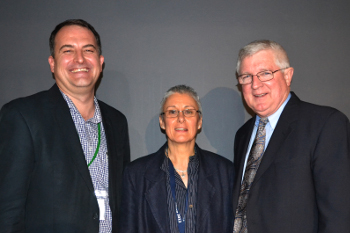 From the left are: Prof Francois Strydom, Director: Academic - Centre for Teaching and Learning, UFS; Dr Lis Lange, Vice-Rector: Academic, UFS; and Prof George Kuh, Adjunct Research Professor of Education Policy at the University of Illinois. |
This year, the privilege to host the annual Higher Education Learning and Teaching Association of Southern Africa (HELTASA) conference was afforded to our university. The event took place on the Bloemfontein Campus from 18 – 21 November 2014, attracting keynote speakers and members from across the world.
HELTASA is a professional association mainly for educators and significant role players in higher education institutions. With its inception in the early 2000s, it has grown to become the premier organisation for teaching and learning in Southern Africa, Dr Amanda Hlengwa, President of HELTASA, pointed out.
A central concern of this body is issues around success within the tertiary sector. The theme of this year, ‘Accessing success: using evidence for change’ served to focus members’ attention on what works and what does not work – as derived from researched evidence.
In a message from Prof Jonathan Jansen, Vice-Chancellor and Rector of the University of the Free State (UFS), he stressed that the task as university teachers “is not simply cognitive gains that ensure graduation success but also intellectual gains that ensure success in life during and after university studies.”
The conference was led by internationally-acclaimed keynote speakers, namely Prof George Kuh, Prof William Grabe and Prof Fredricka Stoller, as well as our own A1 NRF-rated Prof Malanie Walker.
Prof Kuh is Adjunct Research Professor of Education Policy at the University of Illinois and Chancellor’s Professor of Higher Education Emeritus at Indiana University. In his keynote address, Prof Kuh offered valuable lessons from the field to promote student success.
Profs Grabe and Stoller collectively presented the second keynote address that explored how to set up students for success through strategic-reader training. Prof Grabe is Regents’ Professor of Applied Linguistics and Vice President for Research at Northern Arizona University. Prof Stoller is a Professor of English at Northern Arizona University, where she teaches in the MA-TESL and PhD in Applied Linguistics programmes.
Prof Walker is a Senior Research Professor at the UFS Centre for Research on Higher Education and Development (CRHED). She is also currently Director of Research Training and a senior researcher in the EU-funded Marie Curie EDUWEL project. In her keynote address, Prof Walker looked at well-being and agency in higher education.